Monthly economic brief: June 2020
Provides a summary of latest key economic statistics, forecasts and analysis on the Scottish economy.
This document is part of a collection
Labour Market
Scotland's labour market has been significantly impacted by the coronavirus pandemic with the closure of some businesses, the furlough of workers on the Coronavirus Job Retention Scheme and changes in working practices (e.g. home working) in organisations which have been able to continue operating.
Latest official labour market statistics are for the period January to March 2020 and so include only the start of lockdown measures introduced in March. They do not yet reflect significant differences for employment, unemployment and inactivity yet (despite the collapse in economic activity) as furloughed workers (currently estimated at 8.7 million across the UK), are classed as employed.
Latest official labour market statistics[7]
Over the year to January to March 2020 the Labour Force Survey showed:
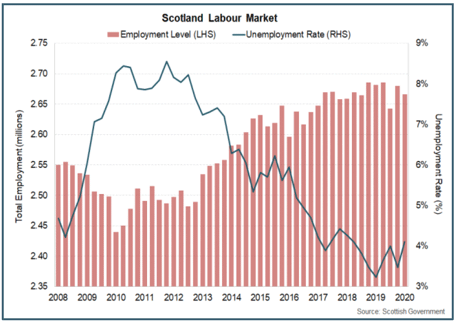
- The employment level decreased by 16,000 and the employment rate fell by 0.8 percentage points to 74.7% (UK; 76.6%).
- The unemployment level increased by 23,000 and the unemployment rate increased by 0.8 percentage points to 4.1% (UK; 3.9%). Youth unemployment increased by 5.4 percentage points to 12%[8].
- The economic inactivity (those neither in employment or ILO unemployed) level increased by 2,000 and the inactivity rate increased by 0.1 percentage points to 22.1 (UK; 20.2%).
Experimental labour market data (ONS) and business survey data provide further insights into other indicators for unemployment, reduced activity through the claimant count (Jobs Seekers Allowance and Universal Credit), hours worked and demand for workers. Collectively they signal that there has been a fall in hours worked and incomes and a rise in unemployment in the second half of March and since the lockdown measures were introduced.
Claimant Count[7]
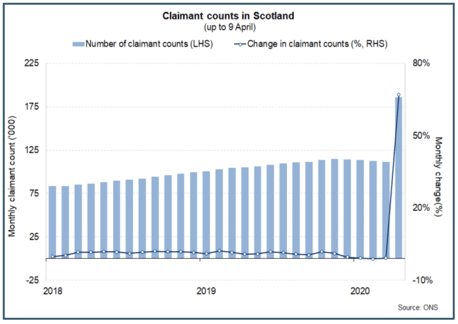
- Scotland's claimant count increased by 67% to 186,000 (claimant count rate of 6.6%) over the month to April, signalling that incomes are falling and unemployment is rising. At a UK level, the claimant count increased by 69% to 2.1 million over the month to April.
Hours Worked
- Weekly ONS Labour Force survey data (published for Great Britain as a whole) showed a significant drop in hours worked and a sharp increase in the number of people temporarily away from work in the second half of March as lockdown measures in the UK started to be implemented.
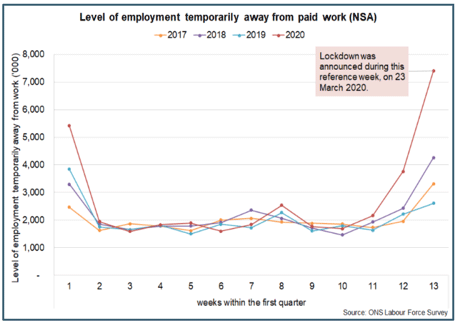
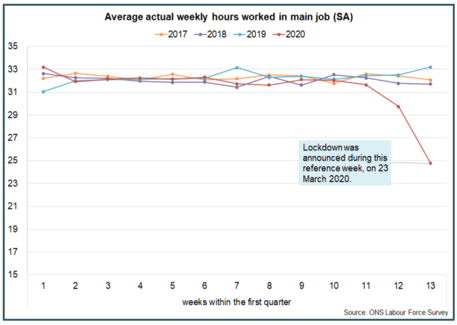
Demand for Staff in Scotland
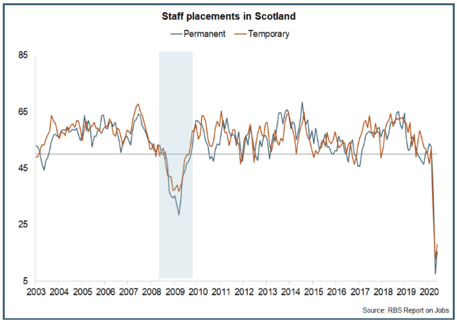
- The RBS Report on Jobs survey for May[9] reported further sharp falls in demand for permanent and temporary staff in Scotland, albeit to a lesser extent than in April.
- This reflects the fact that many firms have frozen hiring permanent and temporary staff during the pandemic and the fall in staff placements in Scotland is mirrored across the UK.
Historic Recessions and Downturns and their effects on the Labour Market
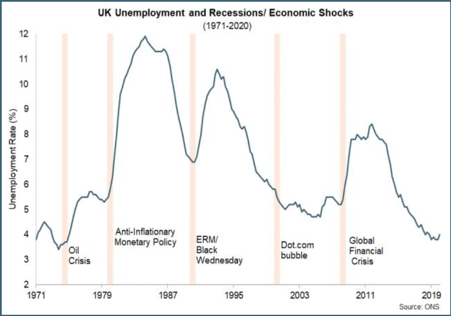
Historically, economic downturns or recessions have tended to have relatively persistent impacts on the UK labour market. The adjacent chart shows the major historic recessions or downturns and the UK unemployment rate over the past five decades[10].
Although each recession and recovery is different, both in cause and duration, the labour market usually takes a long time to recover. Since 1970, the labour market has often taken more than 6 years to fully, or only partially, recover to a pre-crisis level.
Scottish labour force survey data only goes back to the 1990's which is why the UK series was used for this analysis to show a longer term perspective, however, the two labour markets are highly correlated and Scotland shows a similar pattern since 1990.
There are many reasons why high levels of unemployment can be persistent. For example there can be job matching issues, where those made unemployed have different skill-sets to the vacancies that are then available. This can result in a loss of skills and specialist knowledge, demotivation and time to re-train or find opportunities that do match a skill set. Furthermore, vacancies tend to decrease as firms go bankrupt and it takes time to allow for demand to recover and for new businesses and job opportunities to be created to meet this demand.
It is still unclear how persistent labour market impacts from the COVID-19 crisis may be, as the downturn is unprecedented in both magnitude and cause. The impact on the sectors of the economy has not been uniform, with certain industries hit much worse than others, and this may or may not exacerbate any barriers for those affected to re-enter the labour market. However, despite this uncertainty, there is at least some historical evidence to suggest that a labour market rebound may not be swift, and that there could be a degree of persistence in any recovery.
Contact
Email: OCEABusiness@gov.scot
There is a problem
Thanks for your feedback